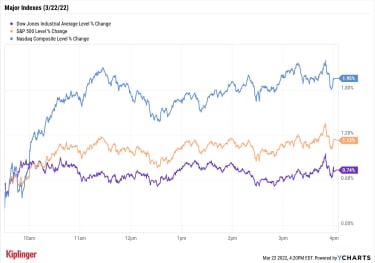Stocks broadly recovered Tuesday as investors continued to weigh Federal Reserve Chair Jerome Powell’s more hawkish tone on inflation and its potential impact on the size and pace of future interest rate hikes.
Kristina Hooper, chief global market strategist for Invesco, says the Fed might be hoping to influence the yield curve more by words than by deeds:
“It’s easy to release an aggressive dot plot and it’s easy to talk tough in press conferences and speeches,” she says. “But it’s a lot harder to actually raise rates seven times in the course of one year and four times in the following year and increase the risk of choking off the economic cycle. Hopefully the Fed will not have to be that aggressive.”
In other Tuesday news, Nike (NKE, +2.2%) provided an encouraging signal on consumer sentiment, reporting much-better-than-expected quarterly results on the back of strong demand in North America.
“The consumer remains quite healthy despite [recent] sentiment readings,” says Lindsey Bell, chief markets and money strategist for Ally Invest. “They continue to have excess savings and low debt levels, and spending expectations remain high according to the New York Fed.”
Sign up for Kiplinger’s FREE Investing Weekly e-letter for stock, ETF and mutual fund recommendations, and other investing advice.
The Nasdaq led the way higher thanks to gains in consumer discretionary (+2.5%) and communication services stocks (+1.9%), finishing up 2.0% to 14,108. The S&P 500 (+1.1% to 4,511) and Dow (+0.7% to 34,807) also closed well in the green.
YCharts
Other news in the stock market today:
The small-cap Russell 2000 closed 1.1% higher to 2,088.U.S. crude oil futures slid 0.3% to $111.76 per barrel.Gold futures declined 0.4% to $1,921.50 per ounce.Bitcoin pared some of its gains near the end of Tuesday’s regular stock-market trading hours, but still climbed 2.8% to $42,345.91. (Bitcoin trades 24 hours a day; prices reported here are as of 4 p.m.)Want to Benefit From Rate Hikes? Think Regional.Wall Street strategists are keeping a close eye on Treasury yields. That’s not just because the Fed’s benchmark rate is heading higher – it’s because of growing worries over what the yield curve is doing (and more importantly, what it signals).
“The U.S. yield curve, or 2- and 10-year U.S. Treasury spread, is flattening,” say BofA Securities strategists. “If this continues, the risk is for an inverted yield curve. 2-10 inversions have preceded the last eight recessions and 10 out of the last 13 recessions.”
That makes for a precarious situation for financial stocks. In general, they benefit from rising interest rates, as they’re able to charge borrowers wider spreads over what they pay depositors for loans.
Although an inverted yield curve (and the economic backdrop that would cause it) would be less than ideal for the industry, investors should by no means panic. Morgan Stanley analyst Betsy Graseck notes that even a shallow inversion shouldn’t be a major drag on financials.
“Banks generated positive loan growth in each of the 11 periods of (two-year/10-year) curve inversions since 1969,” she says. Even better, if the Fed is able to steer through this rate-hike cycle without triggering a recession, financials could be off to the races.
That’s especially true for regional bank stocks, which are more sensitive to interest rates than shares in their bigger, more diversified peers. Have a look at the stocks of four regional lenders, all of which get strong seals of approval from Wall Street’s experts:
